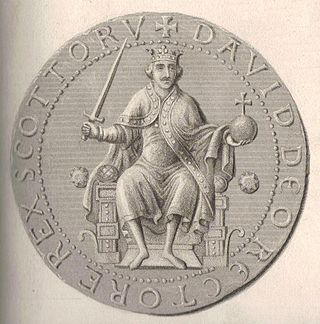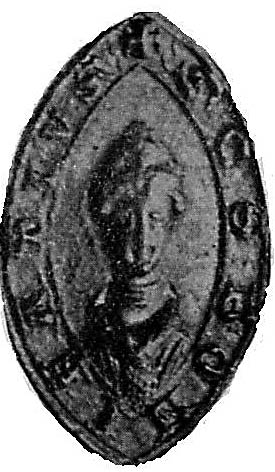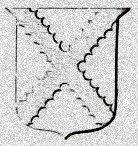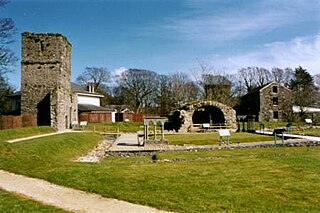Related Research Articles

Donnchadh was a Gall-Gaidhil prince and Scottish magnate in what is now south-western Scotland, whose career stretched from the last quarter of the 12th century until his death in 1250. His father, Gille-Brighde of Galloway, and his uncle, Uhtred of Galloway, were the two rival sons of Fergus, Prince or Lord of Galloway. As a result of Gille-Brighde's conflict with Uhtred and the Scottish monarch William the Lion, Donnchadh became a hostage of King Henry II of England. He probably remained in England for almost a decade before returning north on the death of his father. Although denied succession to all the lands of Galloway, he was granted lordship over Carrick in the north.
Jocelin was a twelfth-century Cistercian monk and cleric who became the fourth Abbot of Melrose before becoming Bishop of Glasgow, Scotland. He was probably born in the 1130s, and in his teenage years became a monk of Melrose Abbey. He rose in the service of Abbot Waltheof, and by the time of the short abbacy of Waltheof's successor Abbot William, Jocelin had become prior. Then in 1170 Jocelin himself became abbot, a position he held for four years. Jocelin was responsible for promoting the cult of the emerging Saint Waltheof, and in this had the support of Enguerrand, Bishop of Glasgow.
Enguerrand was a twelfth-century bishop of Glasgow. He had previously been Archdeacon of Teviotdale, and had served king Máel Coluim IV as Chancellor of Scotland between 1161 and 1164. He was elected Bishop of Glasgow on Sunday, 20 September 1164, and consecrated on 28 October at the hands of Pope Alexander III himself in Sens, France, where the Pope was then resident. He did not return to the diocese until 2 June 1165. Although he resigned the position of Royal Chancellor upon election to the bishopric, there is charter evidence that he once again became Chancellor in the reign of King William the Lion, probably in the year 1171. Notable actions of his episcopate included, probably on the request of his friend Jocelin, then Abbot of Melrose, the opening of the tomb of the emerging saint Walthoef. He died on 2 February 1174.

Historical treatment of David I and the Scottish church usually emphasises King David I of Scotland's pioneering role as the instrument of diocesan reorganisation and Norman penetration, beginning with the bishopric of Glasgow while David was Prince of the Cumbrians, and continuing further north after David acceded to the throne of Scotland. As well as this and his monastic patronage, focus too is usually given to his role as the defender of the Scottish church's independence from claims of overlordship by the Archbishop of York and the Archbishop of Canterbury.
Simon de Tosny was a 12th-century Cistercian monk and prelate. Simon was a monk of Melrose Abbey, and served there until he moved to become Abbot of Coggeshall Abbey in Essex. He resigned this abbey in 1168, and returned to Melrose. In 1171, he was elected as Bishop of Moray, and was consecrated at St Andrews on 23 January 1172. He was a distant cousin of King William who may or may not have played some part in his election. His cathedral was at Birnie, Moray. He witnessed several charters and was present at the Council of Northampton in 1176. He is the first bishop named on the bishop-list in the Moray Registrum. He died on 17 September 1184 and was buried in Birnie Kirk. Aside from the brief episcopate of Andrew he was succeeded as bishop by Richard de Lincoln.
Walter was Chamberlain of Alan, Lord of Galloway and later Bishop of Galloway. As Alan's chamberlain, he succeeded Bishop John after the latter's death, in 1209. His election coincided with the northern expedition of King John of England to secure the submission of King William of Scotland; Alan enjoyed friendly relations with the English king, the latter wishing to make use of Alan's manpower and naval resources, and so the election of Walter may have had something to do with King John.
John of Whithorn was the medieval Bishop of Galloway. His first appearance as bishop-elect is at the coronation of Richard, Cœur de Lion as King of the English at Westminster Abbey on 3 September 1189. He was consecrated at Pipewell Abbey, Northamptonshire, on Sunday 17 September 1189.

Henry was a 13th-century Augustinian abbot and bishop, most notable for holding the positions of Abbot of Holyrood and Bishop of Galloway.

Gilbert was a 13th-century Cistercian monk, abbot and bishop. His first appearance in the sources occurs under the year 1233, for which year the Chronicle of Melrose reported that "Sir Gilbert, the abbot of Glenluce, resigned his office, in the chapter of Melrose; and there he made his profession". It is not clear why Gilbert really did resign the position of Abbot of Glenluce, head of Glenluce Abbey in Galloway, in order to become a mere brother at Melrose Abbey; nor is it clear for how long Gilbert had been abbot, though his latest known predecessor is attested last on 27 May 1222. After going to there, Gilbert became the Master of the Novices at Melrose.
Odo Ydonc was a 13th-century Premonstratensian prelate. The first recorded appearance of Odo was when he witnessed a charter by Donnchadh, Earl of Carrick, on 21 July 1225. In this document he is already Abbot of Dercongal, incidentally the first Abbot of Dercongal to appear on record.
Gregoir [Gregory, Gregorius] is the third known 12th century Bishop of Ross, an episcopal see then based at Rosemarkie.

Robert was a 13th-century prelate based in the Kingdom of Scotland. He was successively Archdeacon of Ross and Bishop of Ross; he is the second Robert to have held the bishopric of Ross.
Robert Capellanus, was a chaplain of King William I of Scotland and afterwards, Bishop of Ross (1214–1249).
Laurence de Ergadia was a thirteenth-century Scottish bishop. Probably from the MacDougall kindred of Argyll, Laurence had become a Dominican friar and presumably university graduate before being elected Bishop of Argyll, an election which took place sometime between 1262 and 1264. Although the election was quashed by the Pope in 1264, the Pope gave him a fresh provision to the bishopric. Laurence appears intermittently in the records during his three and a half decade episcopate, but his activities in his own diocese are badly recorded. He died as Bishop of Argyll sometime in either 1299 or 1300.
Laurence is the first Bishop of Dunblane to be known by name. A document dating to 27 February 1155, had an M. de Dunblan, but no more is known of this man and it is unlikely that M. is a mistake for La..
Simon is the third known 12th century Bishop of Dunblane. Nothing is known of Simon's background as there are numerous Simons in Scotland in this period, both native and foreign. There is a Symon de Liberatione who witnessed a charter of King William the Lion and whom Watt and Murray suggested may have been the later Bishop of Dunblane, while there was in the same decade a local landholder and ecclesiastical patron in the diocese of Dunblane called Simón son of Mac Bethad.

Nicholas de Balmyle, also called Nicholas of St Andrews, was a Scottish administrator and prelate in the late 13th century and early 14th century. A graduate of an unknown university, he served his earliest years as a clergyman at St Andrews, moving on to hold churches in Lothian as well as deputising to two archdeacons of Lothian.
Bernard was a Tironensian abbot, administrator and bishop active in late 13th- and early 14th-century Scotland, during the First War of Scottish Independence. He first appears in the records already established as Abbot of Kilwinning in 1296, disappearing for a decade before re-emerging as Chancellor of Scotland then Abbot of Arbroath.

William Russell was a fourteenth-century Cistercian prelate. He appears to have begun his career as a Cistercian monk at Rushen Abbey on the Isle of Man (Mann), ascending to the rank of abbot there, before being elected Bishop of Mann and the Isles (Sodor). After traveling to Continental Europe for confirmation and consecration, avoiding a trip to the metropolitan in Norway, he returned to the Irish Sea as a legal bishop. A few things are known of his episcopate, particularly his activities in England and a series of provincial statutes apparently promulgated under his leadership.

William de Crachin was a prelate active in the Kingdom of Scotland in the 13th century. The earliest known Dean of Brechin Cathedral, his first appearance in a surviving source comes 22 September 1248, from a document of Arbroath Abbey.
References
- Anderson, Alan Orr, Early Sources of Scottish History, 2 vols, (Edinburgh, 1922)
- Barrow, G. W. S. (ed.), The Acts of William I (Regesta Regum Scottorum vol. ii), (Edinburgh, 1971)
- Crawford, Barbara Elizabeth, "Peter's Pence in Scotland", in G.W.S. Barrow (ed.), The Scottish Tradition: Essays in Honour of Ronald Gordon Cant, (Edinburgh, 1974), pp. 14–22
- Dowden, John, The Bishops of Scotland, ed. J. Maitland Thomson, (Glasgow, 1912)
- Duncan, A. A. M., "Roger of Howden and Scotland, 1187-1201", in Barbara E. Crawford (ed.) Church, Chronicle and Learning in Medieval and Early Renaissance Scotland: Essays Presented to Donald Watt on the Occasion of the Completion of the Publication of Bower's Scotichronicon, (Edinburgh, 1999), pp. 135–59
- Fawcett, Richard, & Oram, Richard, Melrose Abbey, (Stroud, 2004)
- Stevenson, Joseph (ed.), Chronica de Mailros; E Codice Unico in Biblioteca Cottoniana Servato, Nunc Iterum in Lucem Edita. Notulis Indiceque Aucta., (Edinburgh, 1835)
- Watt, D. E. R., Fasti Ecclesiae Scotinanae Medii Aevi ad annum 1638, 2nd Draft, (St Andrews, 1969)